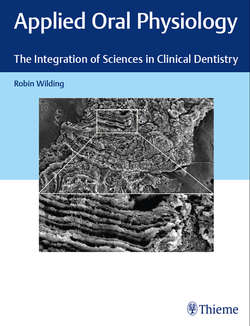Читать книгу Applied Oral Physiology - Robin Wilding - Страница 11
На сайте Литреса книга снята с продажи.
2.1 Enamel: Clinical Aspects 2.1.1 Enamel Minerals
ОглавлениеEnamel is about 95% mineral by weight but 87% by volume. Most of this mineral is hydroxyapatite, but there are other apatites and other minerals (magnesium and carbonates), so the mineral phase of enamel is not pure hydroxyapatite. The less mineralized the enamel is, the whiter and more opaque it is; the more mineralized, the more translucent enamel allows the yellow color of the underlying dentin to show through. Examples of white, poorly mineralized enamel are the enamel of deciduous teeth and chalky patches of fluorosis and early carious lesions in adult teeth. Enamel crystals are about 10 times thicker and much longer than the apatite crystals of bone or dentin; the volume is about 1,000 times greater. The surface area is therefore relatively low, and this factor makes enamel crystal less reactive and soluble to acids than are apatite crystals of bone or dentin. The crystal also contains very little of the more soluble carbonates and magnesium salts found in dentin and bone. The enamel crystals are highly orientated and tightly packed. These factors account in part for the greater hardness of enamel in comparison to dentin and also for its resistance to acid demineralization. In addition, enamel has a lower percentage of organic material than dentin (see Appendix B Table B.1).
Enamel crystals are packed into larger units, the enamel prism, which is the structure made by each ameloblast as it lays down enamel during development. The prisms are about 100 crystals wide but are very long and may run uninterrupted from the dentin to the tooth surface. Both crystals and prisms have their long axis parallel to each other and are directed toward the surface of the tooth. However, at the prism boundaries, the crystals tend to turn outward and face their neighboring crystals. In this interprismatic zone, the enamel crystal orientation is slightly less ordered, and there is a little more space between them (▶ Fig. 2.1). This makes the interprismatic regions slightly weaker and more easily disrupted by tooth wear. During wear, whole prisms break off leaving a sharp edge to the enamel which is needed to shred food (▶ Fig. 2.2). During preparation of a cavity for a composite or amalgam restoration, the margins of enamel must be prepared so that all the enamel prisms are supported. This prevents their chipping off later and causing a failure at the margins of the restoration (▶ Fig. 2.3) (see Appendix B.1 Physical Properties of Enamel and Dentin).
